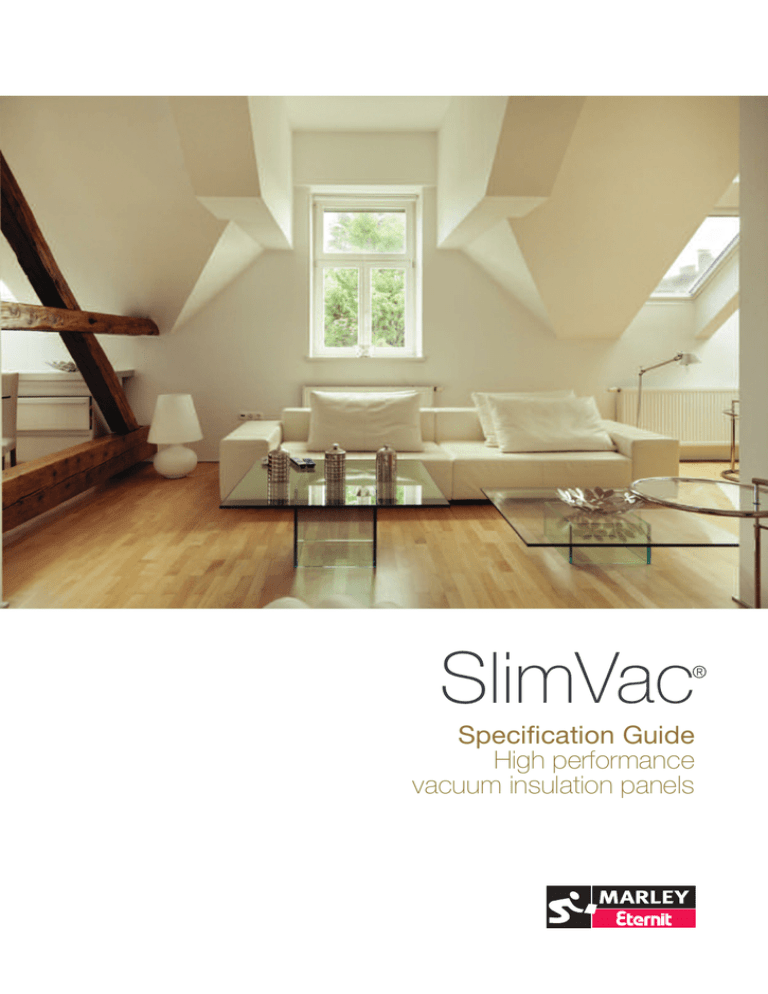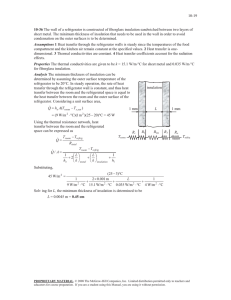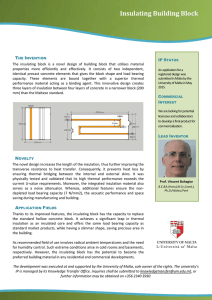SlimVac - Marley Eternit
advertisement

SlimVac ® Specification Guide High performance vacuum insulation panels Contents 03 03 04 2 Thermal insulation of buildings Slimvac product specification History Composition and manufacturing Characteristics Dimensions and tolerances Certification SlimVac Specification Guide 06 08 10 11 12 14 16 Slimvac applications Facades Flat roofs and terraces Ceilings Floors Stud walls (timber and metal) Other applications Case study Thermal insulation of buildings Increasingly demanding regulations covering the insulation of buildings are imposing much higher levels of thermal insulation to all building elements. This leads to more complicated constructions and increases in the thicknesses of insulation materials that need to be incorporated to meet these requirements. There is a growing trend to use super-insulating products like Vacuum Insulation Panels (VIP) in order to limit the thickness of the construction elements. The reason for doing so can be aesthetic but in most cases VIPs are used because there is just not enough space available to install the required volumes of traditional insulation material. Furthermore, because super-insulating materials are lightweight and lower volume, they are significantly easier to transport and thereby limit the carbon footprint and overall cost of the building. SlimVac is a fully certified VIP that has been produced for several years, following extensive product development and testing. The calculating value for the thermal conductivity is certified to be 0.007 W/m.K. The centre of the panel has a coefficient thermal conductivity of 0.0042 W/m.K, however it is important to consider the edge effects of the aluminised foil, therefore we recommend users note the calculating value above. SlimVac Specification Guide 3 Slimvac product specification History of vacuum insulation The first VIP was manufactured in the early 70s and the first areas of application included refrigeration, cold storage and the transportation sector. Soon products and applications for the construction sector were also designed and developed. Due to the nature of VIP itself an adapted system has been developed for construction applications. VIP composition and how it works Several VIP compositions are possible but many years of research and development work has led to the conclusion that an opacified fumed silica based core, covered by an air and water vapour tight barrier foil, placed in a vacuum of around 1 mbar, provides the ultimate insulation product for long-lasting building applications. Fumed silica is a microporous material. This means that its pores are smaller than the mean free path of an air molecule. Furthermore the thermal conductivity through the centre panel is so low, that even before it is put under vacuum, a SlimVac panel has a coefficient thermal conductivity (λ-value) of less than 0.020 W/m.K. 4 SlimVac Specification Guide Achieving the best λ-values The largest loss of thermal energy through standard insulation materials is caused by thermal conduction (due to the presence of gas molecules). Because of this there is very little increase in its λ-value over time. Adding an opacifier to the mix limits the transport of thermal energy through radiation. The barrier foil is a highly engineered foil composed of three metallised (non-aluminium, non heat conductive) polymer films. No aluminium foil is used in the build up as this would ruin the intrinsically perfect insulation properties by creating detrimental thermal bridging along the edges of the panel. Metallised foils keep these thermal bridges to a minimum. All these considerations lead to a super insulating product with a ‘centre-of-panel’ λ-value of about 0.004 W/m.K. However, building applications last for many years, during which minor amounts of water vapour and gases enter the panel reducing the thermal efficiency. Thus, for the calculation value of the coefficient of thermal conductivity one has to take into account aging effects as well as the tiny thermal bridging effect along the edges. These two considerations lead to a calculating thermal conductivity value of 0.007 W/m.K for SlimVac. Characteristics Dimensions and tolerances Density 170 – 200 kg/m³ Standard thickness Compressive strength 160 kPa SlimVac can be made in every thickness between 10 and 40 mm subject to minimum order quantities and additional cost. Internal pressure < 5 mbar Coefficient of thermal conductivity Calculation value including aging and edge effects 0.007 W/m.K At the centre of the panel 0.0042 W/m.K Before being put under vacuum 0.020 W/m.K Water vapour resistance factor of the barrier foil µ = 340.000 10, 15, 20, 25, 30, 40 mm Standard dimensions (available on stock) 1300 x 600 mm 1200 x 600 mm 600 x 600 mm 600 x 500 mm* 600 x 400 mm 600 x 200 mm 400 x 300 mm SlimVac can be made in all sizes (at additional cost) between 400 mm < length < 1300 mm 200 mm < width < 600 mm Tolerances Water vapour diffusion-equivalent 30 m air layer thickness (sd) or (µd) value Resistance to moisture of a non-protected SlimVac Permanent ambient relative humidity < 60 % Resistance to heat Ambient temperature < 80°C Classification for reaction to fire Core: A1 (EN) SlimVac panel B2 (DIN) Resistance to fire When SlimVac is integrated in a construction or a building element for thermal insulation reasons, it will largely contribute to the resistance to fire of this element. Length +2 / - 6 mm Width +2 / - 6 mm Thickness < 20 mm 20 to 30 mm > 30 mm +1 / -1 mm +1 / -2 mm +1 / -3 mm Flatness 5 mm/m Squareness 5 mm/m * (not available in 10, 15 and 40 mm thickness) Composition and manufacturing Certificates and test reports A SlimVac panel is composed of a microporous core wrapped in a microperforated foil and air-tightly vacuum sealed inside a low permeation barrier film. • EMPA test report The core is composed of several components, these include: • In the process of getting an ETA based on a newly written CUAP (CSTB-France) • Zulassung certificate: DIBt • Fumed silica • Test report: B2 classification (DIN) • Opacifier • Test report: FIW München • Organic reinforcing fibres This powdery blend is compressed to a block with a density ranging from 170 to 200 kg/m³. ISO and CEN are in the process of writing an ISO / EN standard on Vacuum Insulation Panels. To avoid dust from the core material being deposited onto the area where the barrier foil is sealed, a microperforated foil is wrapped around the core. This composite is inserted in a pouch made of barrier foil and sealed in an environment where the pressure is reduced close to 1 mbar. Such a barrier foil is a highly sophisticated composite of three metallised polymer films lined at one side with a Linear Low Density Polyethylene sealing layer. This last layer is used to create a welded seam. SlimVac Specification Guide 5 Slimvac applications Facades A variety of facade systems can use SlimVac as the insulation element: • Ventilated rainscreen cladding • Brick cavity walls • EWI • Integral lightweight stud walls (see page 12) 6 SlimVac Specification Guide Benefits • Minimal thickness of insulation layer with maximum performance. • Double layer application: minimises the effect of the thermal bridges caused by the timber battens. Ventilated rainscreen cladding In this type of application, the SlimVac panels must be protected against rain or high relative humidity. Therefore encapsulated SlimVac is used. Between the different layers of SlimVac panels high density PU strips can be inserted. In this way, thermal bridging is limited to a minimum and the timber batten carrying the lining board can be fixed in the load bearing wall without damaging the SlimVac. Example shows Cedral Weatherboard. Brick cavity wall For this type of construction, encapsulated SlimVac must be used. The cavity wall anchors should be carefully fixed through the joints between the SlimVac panels. Rendered external insulated (ETICS) Again encapsulated SlimVac panels must be used. They are fixed using PVC profiles and finished with an appropriate exterior rendering system. SlimVac Specification Guide 7 Flat roofs and terraces General description 1 Watertight roof finishing 1 2 2 PUR / PIR protection layer 3 4 3 SlimVac 4 Protective layer 5 Vapour barrier 6 Concrete roof 8 SlimVac Specification Guide 5 6 Existing flat roofs are, in most cases poorly insulated. When they require upgrading to the new national building standards for roof insulation, thick layers of traditional insulation may be required. This however creates detailing problems: 1 The distance between the watertight finishing of the perimeter wall and the top of the roof finishing must be ≥ 150 mm. 2 Detailing around skylights. 3 Detailing around pipes penetrating the roof. 4 When the roof is linked to a cavity wall, the distance between the water drainage layer in that cavity wall and the top of the roof finishing must be ≥ 150 mm. There are many arguments for using SlimVac in such applications. In the worst case, when no space at all is available for extra insulation, one can replace the existing insulation with a layer of SlimVac. In most cases a thin SlimVac layer can be added to the existing roof construction. In this way, the total cost of the project can be lower than the use of additional thicker layers of traditional insulation materials with the additional construction detailing issues, which can increase costs. Newly built insulated flat roofs can be designed in such a way that thick layers of traditional insulation materials can be incorporated. However, if the new roof requires a gutter to be added, in most cases this would be carried out by locally reducing the thickness of the applied insulation layer, potentially creating a thermal bridge in that area. This can be avoided by using SlimVac® for the new gutter construction. Benefits • Minimal thickness of insulation layer with maximum performance. • Building regulations can limit the height of certain floor levels – with SlimVac one can still meet the thermal insulation requirements. • No increase to the height of the perimeter wall in case of renovation, which, in certain cases is not permitted by local building regulations. • No requirement to change the level of the water drainage layer in a cavity wall. • No need to dismantle and adjust the height of the connection of the skylights. SlimVac Specification Guide 9 Ceilings When there is a non-heated space under an inhabited area, the floor should be highly insulated to limit the downwards loss of heat. Insulating a floor can create structural and height issues, especially in the case of renovation. It would be much easier to insulate the ceiling in the area below but in many cases there is too little space available. For instance, the space below could be a garage, a cellar or completely open accessible area under the house. In such cases, the solution is to fix timber battens to the soffit and to insert SlimVac in between the battens and to use a fibre cement sheet as a lining board protecting the SlimVac panels. The SlimVac panel size will dictate the batten spacing. Benefits • Minimal thickness of insulation layer with maximum performance. • Ideal for limited height in garages under apartments. Technical data for insulated concrete floor (300mm thick) Thickness of concrete floor Thickness of SlimVac Thickness of FC sheet Rt-value U-value (W/m3.K) Rt-value Thermal bridge incl (m2.K/W) U-value Thermal bridge incl (W/m3.K) (mm) (mm) (mm) (m2.K/W) 300 20 12 3.16 0.32 2.16 0.46 300 30 12 4.59 0.22 2.88 0.35 300 40 12 6.02 0.17 3.54 0.28 General description 1 (Concrete) floor 1 2 Timber batten 3 SlimVac 4 Lining board 2 3 4 10 SlimVac Specification Guide Floors On smooth timber or concrete bases Composition: • Protection layer (e.g. 3 mm PE foam) • SlimVac • Protection layer (e.g.: 3 mm PE foam) • Finishing: Dry finishing board, traditional screed On uneven bases Composition: • Protection layer (e.g.: 3 mm PE foam) • SlimVac • Protection layer (e.g.: 3 mm PE foam) • Finishing: Dry finishing board, traditional screed Benefits • Minimal thickness of insulation layer with maximum performance. • Potential consequences of raising floor height on: door dimensions, steps, ducting and wiring, level of radiators are all reduced by using SlimVac. SlimVac Specification Guide 11 Stud walls (timber and metal) General description A light weight exterior wall can be metal frame or a timber frame construction. 7 4 1 Exterior wall finishing (e.g. brick wall, light facade cladding) 4 3 2 2 Cavity 3 Exterior lining board (e.g. Duripanel) 4 Additional standard insulation 5 SlimVac 6 Metal or timber stud 7 Interior lining board 12 SlimVac Specification Guide 6 5 1 In order to meet increased thermal requirements, external lightweight walls are becoming thicker and thicker. Traditionally, external stud walls were constructed to withstand wind pressures, however with the development of thermal building regulations, the thicknesses of the stud walls have become increasingly governed by the thickness of the insulation. Traditional insulation materials such as mineral wool, can increase the width of the profile by up to 220mm plus. However when using SlimVac in the middle of the cavity, the thickness of the wall can be reduced significantly. The advantage of locating SlimVac at the centre of the cavity is that it will not be damaged by the through fixing of the lining boards to the metal studs. Additionally, light objects (paintings, pictures, etc.) can be fixed to the wall without perforating the SlimVac board. A downside to this type of construction is that the supporting frame (typically metal frame) acts as a thermal bridge. This can be avoided by inserting a compressionresistant insulation material (e.g. high density PU) between the stud and the exterior lining board. An alternative exterior finish is EWI (External Wall Insulation) with a thinner insulation layer. Compression resistant thermal insulation and rendered external insulated (EWI) These stud wall systems can be used for the construction of new buildings but also for the renovation of existing constructions. When, for example, apartment blocks are renovated, the complete facade can be replaced with in-situ built or (partially) prefabricated facade elements that are designed to meet the new requirements for thermal insulation. Benefits • Minimal thickness of insulation layer with maximum performance. • Limited transport cost for prefabricated elements. SlimVac Specification Guide 13 Other applications Window reveals Window reveals are an ideal area of application for SlimVac. They can be an important thermal bridge and in most cases, there is insufficient space to apply the required thickness of traditional insulation materials. It is recommended that a SlimVac panel with a facade cladding board is fixed directly to the wall by means of glue and mechanical fixing where possible. Benefits • Minimal thickness of insulation layer with maximum performance. Curtain walls Curtain wall systems require, in addition to the glazed elements, non-glazed components at each floor level. Commonly, sandwich panels are used for these areas. In order to optimise the thermal insulation performance whilst using thin panels that can be incorporated into the curtain wall frame, SlimVac is bonded in between an exterior and an interior lining board. Benefits • Minimal thickness of insulation layer with maximum performance. 14 SlimVac Specification Guide Pitched roofs – interior roof insulation Renovating the roof from the inside allows the use of SlimVac to maintain the maximum room space. Timber battens can be fixed below the existing roof structure at the required depth for the insertion of SlimVac. After fixing a vapour barrier over the total surface, a lining board is fixed across the battens. Benefits • Minimal thickness of insulation layer with maximum performance. SlimVac Specification Guide 15 Case study Project: Promat Business Centre Applications: Flat roof and facade SlimVac Vacuum Insulation Panels (VIP) were used at the Promat Business Centre as an insulation measure during its renovation. Once installed the flat roof and facade achieved U-values of 0.13 W/m2K and 0.16 W/m2K respectively. The building consists of: • Meeting room for 60 people that can be divided in to 3 smaller meeting rooms • Video conference room • Training room • Foyer 16 SlimVac Specification Guide Flat roof Facade Surface +/- 250 m² Surface Front side +/- 45 m² Composition: Concrete support Vapour barrier 5 mm PE foam 40 mm SlimVac 40 mm PIR Pressure spreading layer Bituminous watertight layer Ballast: granulates Composition 10 mm plaster rendering 140 mm brick wall 8 mm PE foam 40 mm SlimVac between timber battens Breather membrane Timber battens Equitone Tectiva U-value 0.16 W/m²K U-value 0.13 W/m²K Slope of roof surface 2% Other 2 drainage holes SlimVac Specification Guide 17 Call Email Or visit on 01283 722588 at info@marleyeternit.co.uk www.marleyeternit.co.uk/slimvac Marley Eternit Limited, Lichfield Road, Branston, Burton-on-Trent, DE14 3HD


